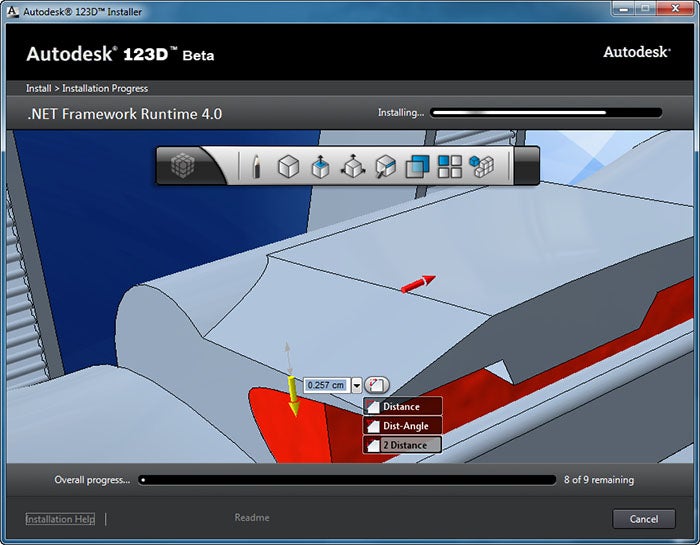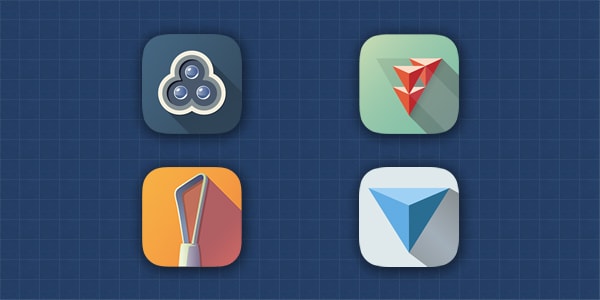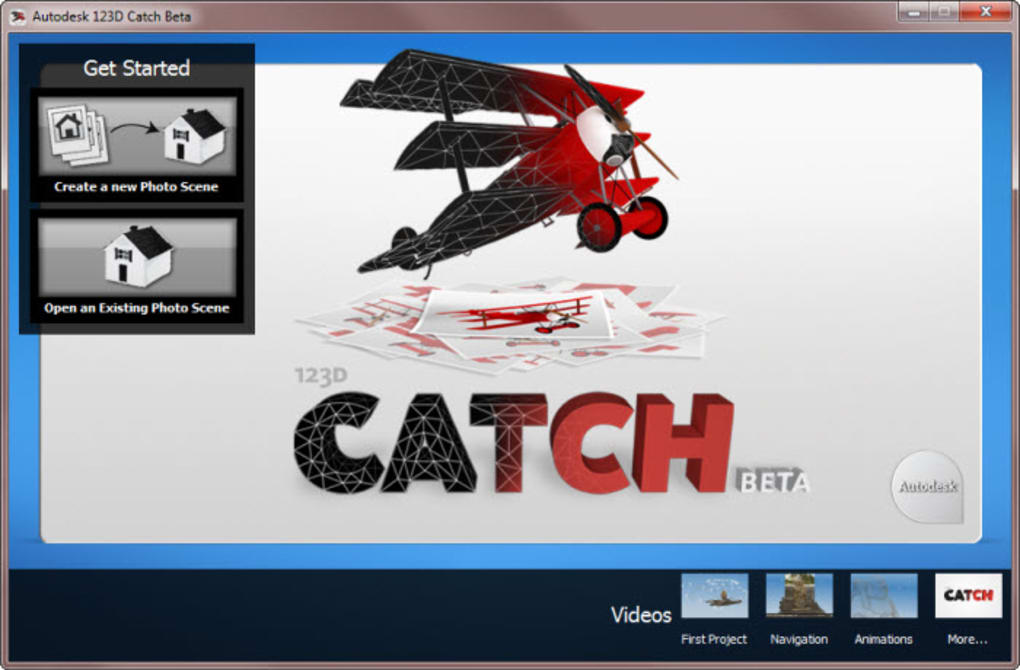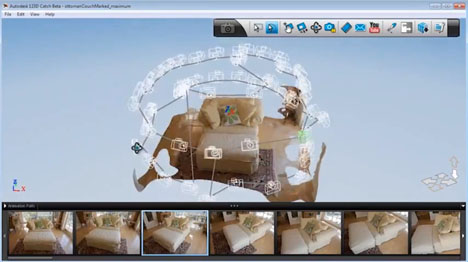EDIT: Autodesk 123D Design has been discontinued as of March 31st 2017. It is no longer available for download from the official site and already downloaded versions will no longer be supported. However, you are able to download it here (install at your own risk).
123d catch free download - 123D Catch, 123D Make, 123D Design Plugin, and many more programs. Download Autodesk 123D Catch. User-friendly 3D design and modeling app with ability to import 2D and 3D designs. Capture 20-40 photos sequentially of a stationary subject, whether it be a person, place, or thing. Use the iPhone, iPad, web, or desktop app to upload your photos to the Autodesk cloud where they.
Lately we have written a couple of posts about CAD, one intro post about CAD for Makers and one post where we look at the free browser based software called Tinkercad.
After the post about Tinkercad we got a tip about Autodesk 123D Design. This is also a free CAD software under the same Autodesk 123D umbrella as Tinkercad. However, it contains a much larger array of tools and power than Tinkercad, and is actually closer to Fusion 360 (which we talked about in the intro post) than Tinkercad.
This is what 123D Design looks like when starting the program.
With the maker movement rapidly advancing throughout the world, CAD software also get more and more available for hobbyists. Over the course of these CAD-related posts we will try to help you get an overview of what’s available and what software is best suited for your needs and skills.
Autodesk 123D Design Comparisons
As mentioned in the intro chapter, 123D Design lays somewhere between Tinkercad and Fusion 360 in terms of complexity, features and power, arguably a bit closer to Fusion. We will try to make some rough comparisons to make your choice easier.
A very quick nonsense-model made in 123D Design using several different tools.
vs Tinkercad
123D Design really steps up from Tinkercad, making it possible to create more complex models. We in NC use Fusion 360 on a daily basis, and when trying out Tinkercad we felt very limited due to the lack of modification tools, among other things. 123D Design reintroduces sketches, fillet, chamfer, extrude, modify as well as numerous other ways to modify the objects, which are all very welcome. You can also delete certain faces (sort of like an “anti-chamfer” or “anti-fillet”), which we personally are huge fans of.
Creating patterns are also included, which are very powerful tools to reapeat features either in a curcular or a rectangular fashion or along a custom path.

The pattern tool used to evenly distribute the seven ellipsoidal cutouts along the edge of the cylinder
We complained about the lack of ortographic view mode in Tinkercad, and luckily this is available in 123D Design. In addition to this, there are several view and camera options available to make your life easier which aren’t present in Tinkercad.
A proper text tool is also included, as a part of the sketch feature, so you don’t have to insert premade letter and number objects.
Another improvement over Tinkercad is the snap tool, which let you select a face of an object and snap it (together with the whole object of course) to another face. The first object will rotate and position itself so it centers on the second face. It has in addition to this snap tool the same align tool as Tinkercad.
123D design also has a proper measure tool, much like what you find in Fusion 360, although not as fleshed out.
The text and measure tools in action. How ’bout some love for the good ol’ Comic Sans? The measure tool shows the shortest length between the two selected edges, the anlge between them and the lengths of the edges themselves.
We have to mention the import/export options as well. There are expanded features here compared to Tinkercad with export and import of STEP and SAT-files, which is convenient.
vs Fusion 360
Being more of a simplified Fusion 360 than an improved Tinkercad software, 123D Design can almost get a bit annoying to work with if you’re used to Fusion (or other larger CAD programs, we have to assume). In Tinkercad you’re so blatantly aware of your major limitations that every feature is a godsend, but in 123D Design there are all these smaller and more subtle limitations which you discover after a while which can almost give you a bit of a headache.
Let’s talk about the major differences first. In 123D Design you don’t have the render, sculpt or CAM modules (among several others), which you all find in Fusion. The browser is not present in 123D Design where you in Fusion have a good overview and management over each instance (components, bodies, sketches and so on). This is essential to have if your assembly consists of several components and extremely convenient to have regardless of the assembly size. You also don’t have anything close to the “capture history”/parametric modelling feature in 123D Design which you have in Fusion. All of the movement, joint and animation-related features are left out of 123D Design as well.
A render done in Fusion 360 (from an earlier post)
Fusion 360 has this construct feature which lets you create planes, axes and points in a wide array of ways to make your life easier. 123D make have nothing of the sort. Every sketch-related tool is also so much more robust in Fusion. Fusion’s snap tool is SO MUCH more flexible and 123D Design also lacks a few inspect tools.
We could’ve gone on and on about all the features missing in 123D Design compared to Fusion, but that would get tedious after a while (you probably get the idea by now). Therefore, we feel that it’s time for a conclusion.
Conclusion

So what should you choose?
It has come to our attention that Fusion 360 is available for free as well, although with some restrictions to whom is eligible for the free version. With this in mind we will assume that all of these three alternatives are free throughout the recommendations below.
In our opinion, Tinkercad is the best choice if you don’t have any previous CAD experience and at the same time don’t need to create complex models. It’s easily accessible due to it being browser-based and it’s also a great way for kids to learn CAD.
123D Design is more difficult to recommend, at least if you can get Fusion for free. The tools in Fusion feel so much more fleshed out in every way and Fusion has so much more to offer in general. The only case we’d recommend 123D Design is if you’re relatively new to CAD, maybe just got the grips on Tinkercad and starting to feel a bit limited (we won’t blame you!). Then 123D Design might be a good stepping stone to larger programs such as Fusion 360 as it’s a bit more beginner-friendly.
Other than that, of all the programs we know of, getting Fusion 360 is a no-brainer if you want to start CAD’ing, given that you’re eligible for the free version. It is really powerful, full of features and it gets new features regularly.

Autodesk 123d Circuits
We hope that this post has given you a better insight in what CAD software you should try out. If there are other good free alternatives you know of, besides Sketchup(which we briefly covered in the intro post), let us know! 🙂
A powerful yet easy to use application that allows you to create a 3D model from photos you take using a simple and practical technique
Autodesk 123D Catch is a remarkable piece of software that allows you to stitch together a number of photos in order to create an explorable 3D model.
Autodesk 123D Catch uses images taken at different angles from the subject and merges them into a complete object. The technique used to take the photos is similar to that needed to create a panoramic photo, except you move around the subject instead of panning in one direction. It then manages to find anchor points and combines the images into your 3D model.
The interface of the application is a comprehensive one, enabling you to easily work with it, regardless of your experience with computers. In order to build your 3D model, you first have to load the images into the application and wait for them to be merged. The time it takes to stitch them depends on their number and your Internet connection speed because they are uploaded to a cloud system where an online engine processes the photos.
Once the model is complete, you can download and open it with Autodesk 123D Catch. Here you can navigate the model in three modes, ‘Orbit’, ‘Dolly’ and ‘Pan’, which enable you to rotate the perspective around the object, zoom in and out, as well as change the view point. This comes in very handy in case you want to check for any flaws in the stitch before you print the object in 3D.

If by any chance some of the photos remain unprocessed,therefore not merged into the model, the application allows you to see which ones and offers you the possibility to manually add them. Autodesk 123D Catch doesn’t complicate this task in any way because all you have to do is choose common features from three images using a magnifying tool.
In closing, Autodesk 123D Catch is a simple to use tool that is capable of creating unique 3D models of anything you think of photographing.
Filed under
Autodesk 123D Catch was reviewed by Alexandru ChirilaAutodesk 123d Design
- Intel Core2Duo
- 1 GB RAM
- 1 GB free disk space
- OpenGL compatible video card (OpenGL version 1.3 recommended) with 256MB or more memory
- Internet connection
Autodesk 123D Catch 3.0.0.90
add to watchlist send us an update
send us an update- runs on:
- Windows 10 32/64 bit
Windows 8 32/64 bit
Windows 7 32/64 bit
Windows XP 32/64 bit - file size:
- 88.7 MB
- main category:
- Science / CAD
- developer:
- visit homepage
Autodesk 123d Catch
top alternatives FREE
Autodesk 123d Make
top alternatives PAID
